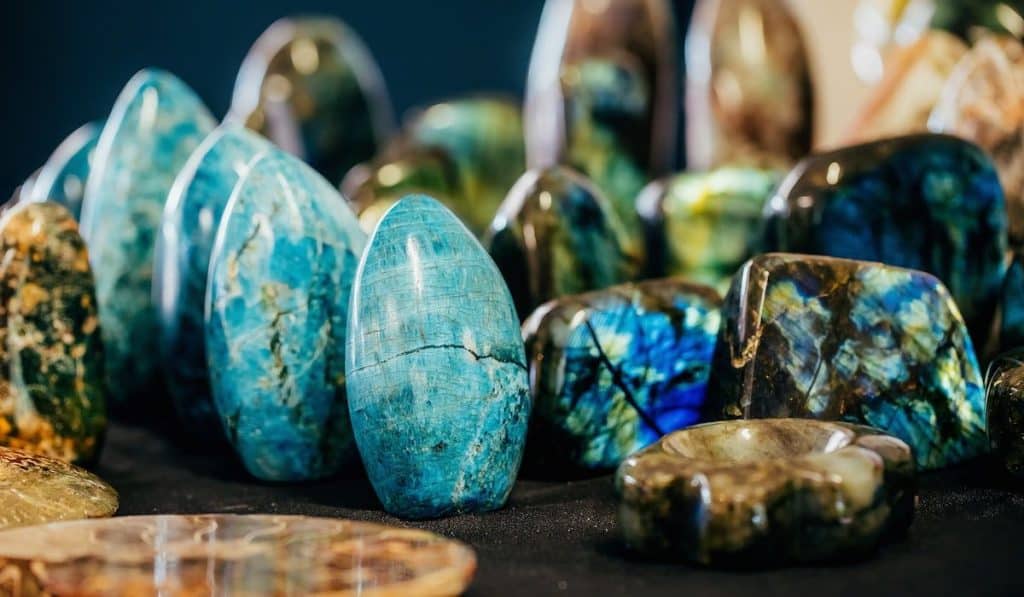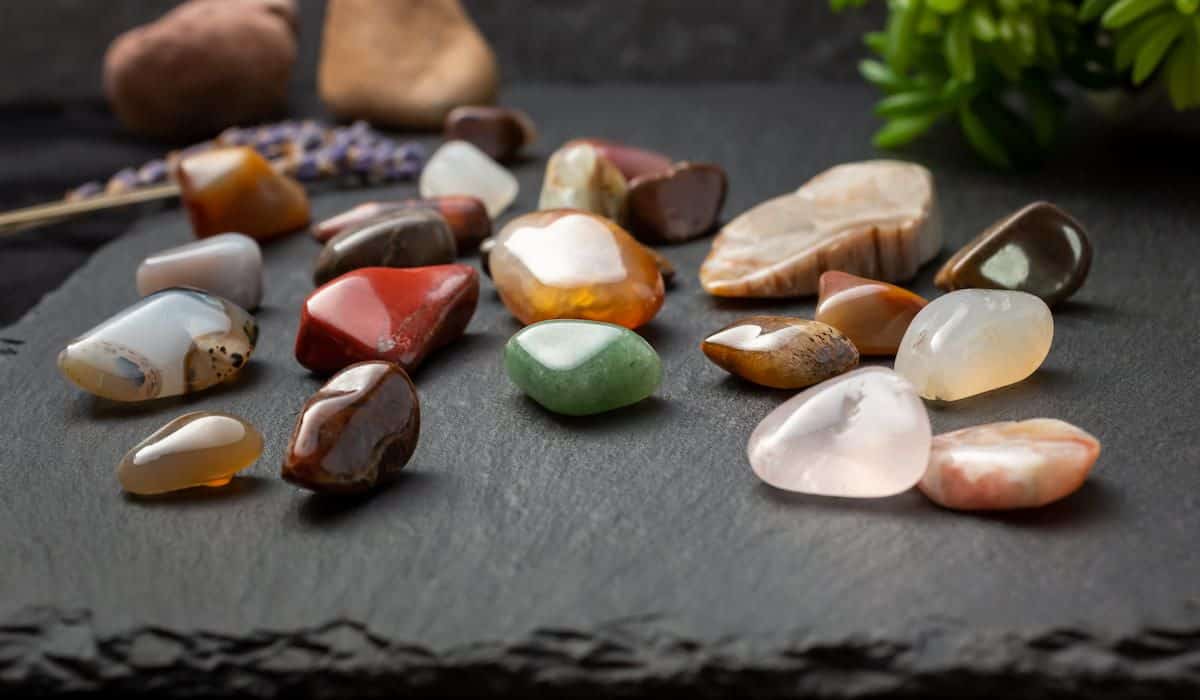Have you ever admired the perfectly smooth stones you’ve seen along beaches, lakes, or rivers? These have been rock tumbled naturally, through grit-like sediment, wind, time, and water. The effect is beautiful and can transform any stone, no matter how rough or raw.
Believe it or not, it is possible to replicate this process at home, with your own rock tumbler. Make your own gem-like stones to turn into jewelry, to enjoy yourself, gift, or sell.
Get Some Healthy Exercise on a Rock Hunting Walk
All of the places you can find them, how pleasant keeping an eye out for them can be, etc.
If you’d like to start exercising a bit more, believe it or not, rock tumbling can do the trick.
To find suitable rocks, you need to walk about and explore a little; and you won’t even be thinking about the exercise; helping yourself get a little more fit is just a bonus, after all.
Whether you’re just going on a small walk or hiking in the forest, you’re in motion, burning calories and improving your blood circulation. Get a bit of color in your cheeks and stretch your legs (or your arms if you are using a wheelchair!), while you keep your eye out for the perfect rock.

Get Out Into Nature
Are you looking to get out into nature more? The great outdoors will improve your very quality of life and has so much to offer. Nature is good for the body, and the soul. All of that visual beauty, birdsong, wind in the leaves, and just plain, good-ol’ fresh air.
Rock tumbling can be a great encouragement to get out into nature, with all of those unique rocks out there for you to discover. You can find rocks closer to home, with a simple walk, or you can visit a forest and hike a trail.
Soon, you’ll have become familiar with the best places to look – around the roots and stumps of trees, along streambeds, at the bottom of a cliff, etc.
Your rock hunt can take you so many wonderful places, all steeped in natural wonder.
Therapeutic
The key to peace-of-mind has been found, time and time again, presence of mind. This means allowing yourself to take in the beauty that each moment has to offer. Of course, this is easier said than done!
So that their mental energy (worry, etc.) has somewhere to go, many find some sort of task to be helpful: gardening, baking… and rock tumbling, too.
You’ll need to pay attention in order to find the most promising rocks, after all! Perhaps one with a bit of blue? As you examine the sidewalk, or the forest trail, searching for shape and color, your mind is full of childlike wonder.
And you’ll get a pocket full of rocks as a reward for your effort – which can then be tumbled into shiny little treasures that you helped create – win-win!
Make and Sell Jewelry
Rock tumbling will completely transform your average rock. It will acquire a strikingly gem-like luster. This makes tumbled rocks perfect for starting a jewelry-making business, which couldn’t be easier.
To turn your freshly tumbled treasures into jewelry, all that you need is some flexible wire (about 20 gauge, you can get this at your local craft store or online), some necklace chains or strings, and perhaps a drill.
You can either wrap a stone in wire (there are some fun techniques online) and turn it into a necklace; or drill holes in the stones and thread them through one by one – whatever suits your fancy!
What can you do with tumbled rock jewelry? You can wear it yourself, gift it, or even sell it; there is a market for this sort of lovely, homemade decor.

Why Is Rock Tumbling Such a Fantastic Hobby?
1) It’s Highly Accessible
One of the most shining recommendations for rock tumbling is how accessible this hobby is. Anyone can do it; all you need is your own rock tumbler and a likely rock!
You can bend down to pluck up interesting rocks or collect them with a net or scoop by wheelchair. Or, you can even have your kiddos collect a few for you to tumble together.
Rocks can be found anywhere and aren’t available just to a few!
2) Tumbling Rocks is (Virtually) Free
Compared to most hobbies, rock tumbling is virtually free, once you’ve obtained a rock tumbler (these can always be purchased online and can sometimes be found at the store).
All that you need is the perfect rock. Or a whole bucketful. These can be found along sidewalks and paths, in your garden, along streambeds… pretty much anywhere you go, you will be able to find a – free! – rock, or several.
Along with the initial purchase of the rock tumbler and supplies, you may need to occasionally restock.
Grit is nice and affordable, however (not much more expensive than cheap sandpaper).
3) Do You Need to Take Lessons to Learn How to Tumble Rocks?
Do you need to take lessons to learn how to tumble rocks? Not at all! This is one hobby that truly couldn’t be simpler. All that you need are some rocks you’d like to smooth, some grit, and your own tumbler.
You may find yourself taking part in this hobby without even meaning to, out of habit, as rocks catch your eye more and more.
You’re sure to develop a good eye for the ones that will turn out your favorite, i.e. with dark tones, or plenty of granite-like coloration, etc.
This being said, it’s always fun to look for inspiration and useful information: for example, what rocks are recommended the most highly? What can you make with tumbled rocks? In no time, you will be a natural rock tumbler!
4) Is Rock Tumbling an Indoor or Outdoor Hobby?
Rock tumbling is both an indoor and an outdoor hobby, the best of both worlds, really. On days you are feeling up to it, you can go on a pleasant hike or walk.
If you’d rather stay in, you can check on the rocks that you’ve already got tumbling, or get crafty with the ones you’ve already tumbled to perfection, etc.
You do not even need to leave your yard to find a few rocks – just give your garden yard a look-over. If you’re feeling adventurous, the all-time best places to find rocks to tumble are – you guessed it – mountains, forests, streams, lakes, etc.
Make sure to store up a whole bunch of rocks for the cold season, as rock tumbling is at least partly outdoor. As you can probably imagine, it’s not quite as easy – or comfortable – to find rocks in the snow and chill of winter. This is an ideal season to focus on your crafts, and on transforming the rocks you’ve already collected in your tumbler.
5) Is Rock Tumbling Done Alone, in a Group, or With Family?
You can invite friends or family along, or enjoy rock tumbling yourself. Either or. On your own, you can relish the quiet time and sounds of the outdoors while you hunt; with friends or family, you can chat, and point out the most interesting rocks that you see to each other!
What Makes a Rock Good for Rock Tumbling?
You can tumble almost any rock, but with some, the results will be a lot better.
First off, the rock should not be too soft, as it may end up breaking or falling apart in your tumbler. That being said, the rock should not be too hard, either – this can cause it to smooth unevenly, or fail to tumble altogether.
Porous rocks also aren’t ideal, as the surface simply won’t become as smooth, and the holes may turn into cracks or grow larger.
Instead, look for rocks that are your typical, medium-hardness, and don’t worry about small bumps, ridges, or even a very rough texture… these can all be polished-up beautifully in your rock tumbler.
The Best and Worst Rocks for Rock Tumbling
Best Rocks for Rock Tumbling

- Quartz. Generally, you don’t want to try to tumble anything harder than quartz (topaz, for example). The hardness of quartz is considered ideal. This means rose quartz, smokey quartz, classic clear quartz… just about any kind of this commonly found stone is OK.
- Citrine. Citrine is another type of quartz (many beautiful stones are), and it’s perfect for your rock tumbler. You can polish raw citrine until it shines like amber.
- Fluorite. Compared to some rocks suitable for tumbling, fluorite can be a bit softer. This means you will not want to place any rocks that are harder than the fluorite in the tumbler with it, or they can scratch or break. This being said, fluorite is a transparent, colorful stone that can create some of the most aesthetically appealing jewelry, etc.
- Amethyst. If you like rocks, you’ve probably seen amethyst before. This is by far one of the most popular. With its unique, otherworldly purple hue, amethyst has a truly extraordinary look. It even tends to reveal new shades of purple and bits of clear quartz under the surface when it’s put through a rock tumbler.
- Jasper. Jasper typically comes in various shades of green, brown, red, orange, purple, pink, and yellow. If you find any, you’re most likely to discover some red or green jasper. These stones are multicolored, with stripes, spots, and other details that give them heaps of aesthetic appeal.
- Aventurine. Aventurine is another quartz relative and ideal for a rock tumbler. It comes in green and blue above all. Tumbling Aventurine is sure to bring out different transparencies and colors.
- Agate. Agates look like royal jewels and come in almost any color you can think of. They feature wave-like patterns and stripes, varying translucency, etc. Out of all of the rocks that you can tumble, this is definitely one of the most popular.
- Petrified wood. Did you know that you could tumble petrified wood? It’s true! While wood is usually much too soft to tumble, and fossils are too hard, petrified wood is right in the middle, which means it is perfect for your tumbler.
- Granite. When it comes to rock tumbling, granite is a hit or miss. This lovely stone has many color variations – blue, purple, green, pink – to offer. Granite also tends to contain softer and harder parts, however. This means that some may turn out with holes or pits, where being tumbled has dissolved the softer material. Others can turn out much smoother. Try to pick granite pieces with uniform hardness, if possible, as this will help them to turn out more evenly and overall better.
Worst Rocks for Rock Tumbling
- Sandstone. Have you ever tried to tumble sandstone? This will simply degrade into raw sand again, once in a tumbler. The results? Not very pretty.
- Basalt. If you discover basalt, that’s very cool. This is a very unique, ultra-porous lava rock. It is not suitable for rock tumbling, and will simply fall apart, however. This is one rock you will want to keep just how it is, rather than sending it through your tumbler.
- Topaz. As it turns out, topaz is a stone with too much hardness for rock tumbling. In fact, if there are other, softer stones in the tumbler along with the topaz, it can cause them to scuff or break.
- Any types of stones that fall apart when you rub them together. These will disintegrate into ‘grit,’ which will also prove harsh and abrasive on the other rocks in your tumbler.
How Do You Use a Rock Tumbler?
To use a rock tumbler, all you need to do is add the necessary ingredients to the tumbler: grit and water. The tumbler will start out with the harshest grit, to get rid of big bumps and imperfections, and from there you will work up to grits that are finer and finer.
- Turn rough rocks into polished gems: Discover and learn the fun process of rock tumbling with the Advanced Rock Tumbler. Pour in the rough stones and grit and let the machine do its job!
- Complete kit: Includes: rock tumbler machine, low-noise barrel (1 lb. capacity), 4 grit packets, 1/2 lb. assorted rough rocks, mesh strainer, jewelry fasteners, gem storage bag, and an illustrated easy-to-follow instruction and learning guide booklet.
- Powerful quality: Runs on a powerful heavy duty motor that will last for a very long time, and includes a leak-resistant barrel that runs quieter than the other brands.
As a rule, the rocks that you tumble should vary in size (this helps the process) but should be no larger than ½ the tumbler barrel.
Tumbling rocks to the perfect shine can take up to two months, or as little as one week.
What Supplies Do You Need for Rock Tumbling?
A Good Rock Tumbler
There are rock tumblers of various quality
to choose from, and while not all of us can afford the most expensive one, you won’t want the very cheapest, either. These tend not to really work. If you can, you’ll want to go for at least a middling-quality rock tumbler. These tumblers cost anywhere from as low as $50 to as much as $100+.You may see a couple different kinds of rock tumblers as you look. These are rotary, and vibratory, and rotary are the most popular. Rotary tumblers are also the best for a beginner.
Rotary tumblers consist of a barrel, which consistently turns, rolling the rocks around in the grit and water (much like a river).
Vibratory rock tumblers tend to be much more expensive, as they work more quickly and use a greater amount of electrical power. These function by vibrating intensely, causing the stones to undergo a rapid weathering process – there’s nothing faster.
Grit
Rock tumblers work with grit , which is a very tough, sand-like material (usually made from silicon carbide). You will need a few levels of grit, including harsh, medium, fine, and some sort of rock polisher (TXP aluminum oxide, for example).
- HIGH QUALITY – This rock polisher grit refill pack comes with enough high-quality silicon carbide grit to put a dazzling polish on up to 20 lbs. of rocks, gems, glass, and more
- EASY TO USE FOUR-STAGE ROCK GRIT – The first rock tumbling grit stage provides initial shaping, the second smooths rock surfaces, the third pre-polishes rocks, and the fourth provides the final polish
- COMPATIBLE WITH ALL TUMBLERS – This complete 4-step rock tumbler grit refill kit works with all rock tumblers. For best results, use with National Geographic Rock Tumblers and rock tumbling supplies
The grits are labeled as roughly 60-500, from rougher to finer.
You will need about 1 TBSP of grit per four rocks, and the grit should decrease naturally over the course of a week.
- Water. Rock tumblers need to be lubricated with regular ol’ tap water.
- A rock tumbler.
- Grit.
- Something to collect rocks in. When you’re looking for rocks, you may find more than you expected! Be sure to bring a bag or bucket, so you can keep as many as you discover.
- Rocks. Last but certainly not least, rock tumblers need… rocks! Just make sure they are suitable (not too hard, not too soft, not porous, etc.).
Rock Tumbling for Children
Rock tumbling can be a super fun activity for children, curious creatures that they are. Kids often collect rocks , pinecones, bugs, etc. Children also like to feel like they accomplished something important (who doesn’t?). Turning hard-found rocks into shiny gems in the rock tumbler fits the bill.
Rock tumbling is a wonderful way for parents and kids to have a bit of whimsical fun and adventure, together.
Rock Tumbling for Adults
Adults can have just as much fun as kids can (well, almost) with a rock tumbler. Not only that, but you can go even further with it: turn the polished rocks into jewelry, gifts, magnets, etc.
This is a hobby that is not only fun, but practical, and it couldn’t be easier – a perfect way for a put-upon adult to take a break and relax with some crafts or a rock-hunting walk!
Can You Tumble Rocks Without Grit?
To tumble rocks, you will need some sort of abrasive material. It has been asked, then, can you simply use sand? From the beach, store, or a river?
Actually, natural sand is typically no harder than quartz, and sometimes it’s softer. This means that it will not have the ability to weather the rocks like it is supposed to, whereas store-bought silicon carbide will.
Can You Reuse Rock Tumbling Grit?
You may be tempted to reuse rock tumbling grit to save a buck. Sadly, this does not work! Each time you use the grit for a round of tumbling, it will not only wear down the rocks but also gradually break down itself.
For that eye-pleasing, shiny-shiny polish, you will want to use a grit that is fresh and new!
Final Thoughts
Maybe rock tumbling just isn’t your thing – that’s OK. There are plenty of other hobbies and some that are different, yet similar. Or maybe you’re way ahead of the game, and already have your own rock tumbler.
You can expand your interests by hunting for geodes (special stones that hide beautiful caverns of crystals inside), or you can even pan for gold, in some areas – perhaps you’d like to give these a try?
These hobbies will also encourage you to get outdoors, and you will potentially come away with some sort of treasure (sparkling geodes, or valuable gold).
As you can see, rock tumbling truly is a wonderful hobby, with so much to offer. This hobby can introduce a bit of fun and whimsy to your life, and help you relax.
As your reward, you’ll soon have a collection of perfectly polished rocks to admire, craft with, gift, and more!





